Pad Woon Sen (Thai Stir-Fried Glass Noodles)
Pad woon sen is an authentic Thai dish featuring stir-fried glass noodles, proteins, and colorful aromatics in a rich umami sauce. This yummy glass noodles recipe is perfect for weeknight meals because it’s quick and easy—plus it packs a lot of flavor and nutrition into one dish!
Gluten-free glass noodles, made with mung bean starch, have a delightfully chewy texture. Make some easy swaps to keep this authentic pan woon sen recipe gluten-free and low-carb, like using kelp noodles instead.

What is pad woon sen?
Pad woonsen is a vibrant Thai stir-fry featuring glass noodles, also known as bean thread noodles because they are commonly made with water and starch from mung beans. The dish combines these noodles with a choice of proteins—commonly chicken, pork, or shrimp—along with eggs and a colorful mix of vegetables like cabbage, carrots, onions, and green onions. It’s seasoned with Thai soy sauce, oyster sauce, fish sauce, and a hint of ground white pepper, making it a staple in Thai cuisine.
What does it taste like
This noodle dish tastes savory with a delicate balance of sweetness and a slight acidity. It’s not as tart as Pad Thai because there’s no tamarind in the sauce.
What it’s made of
- Glass noodles (or substitute Thai vermicelli noodles or other types of Chinese noodles)
- Protein choices like chicken, pork, or shrimp
- Common vegetables such as onion, tomatoes, carrots, and spring onions
- Optional additions like Chinese broccoli (gai lan) or Napa cabbage
- Eggs for richness
Ingredients
This Thai glass noodle stir fry uses simple ingredients to form layers of flavor that explode in every bite. Simple seasonings and colorful aromatics form the flavor foundation of this stir-fry, which is tied together with a sweet, tangy, and umami-rich sauce. Here’s what you need:
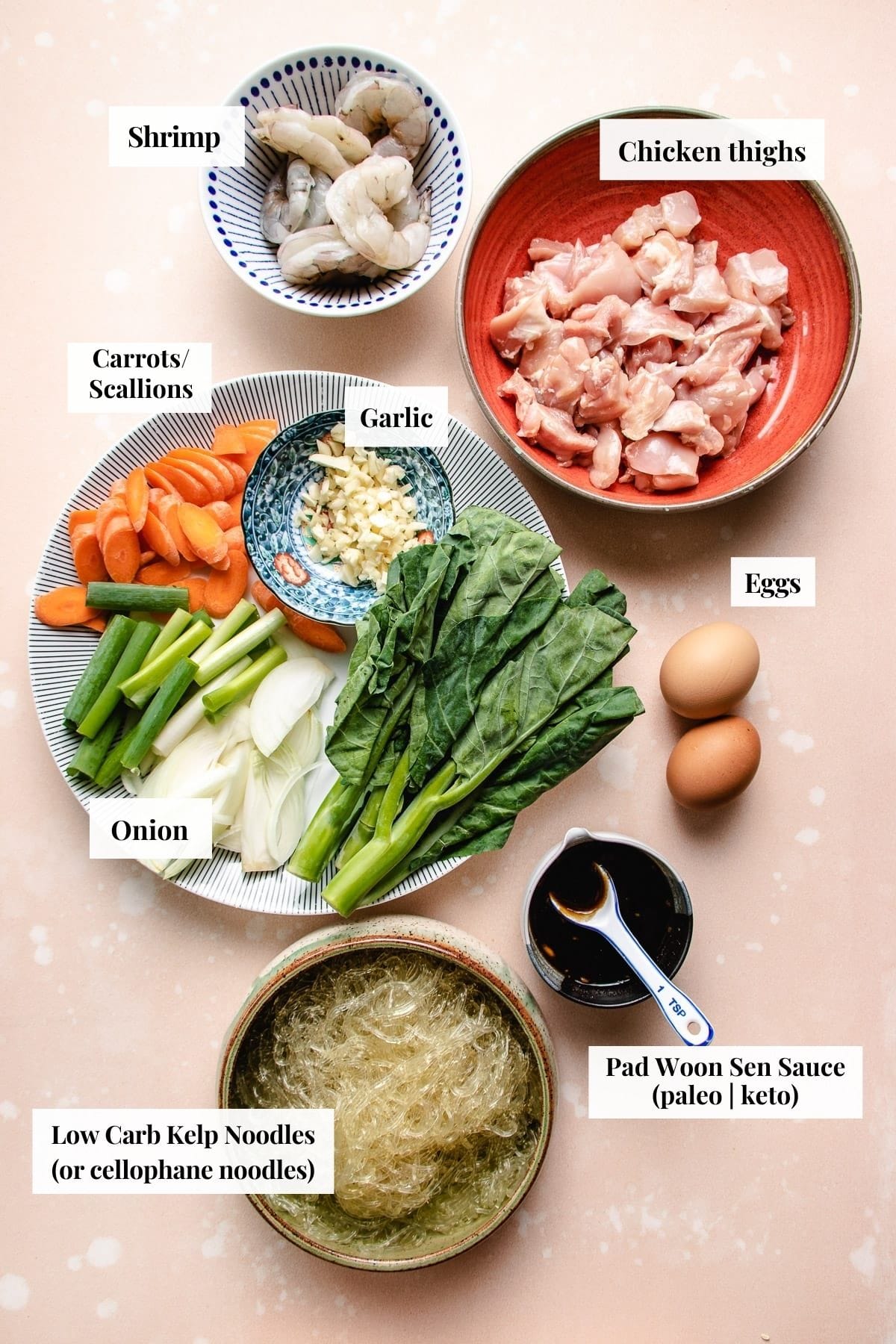
Protein
- Chicken thighs: Skinless and boneless, but into bite-sized pieces or strips.
- Seasonings: Garlic powder, coarse sea salt, ground white pepper (or ground black pepper).
- Large shrimp (optional): About 8 pieces.
- 2 Large eggs
Other stir-fry Ingredients
- Thai glass noodles: Also known as cellophane noodles, bean thread noodles, or mung bean noodles. See substitutions below for more low-carb and gluten-free alternatives.
- Aromatics: Yellow onion (sliced), fresh garlic cloves (minced), carrots (diagonally sliced), and scallions or green onions (diced into 2-inch sections).
- Chinese broccoli: Or use broccolini.
- Avocado oil: A neutral-flavored oil good for stir-frying.
Pad woon sen sauce
- Soy sauce: Or sub twice the amount of coconut aminos for gluten-free and soy-free.
- Fish sauce: An authentic Thai ingredient. Adjust to taste.
- Oyster sauce: Adds a deep umami flavor and helps to thicken the sauce.
- Coconut sugar: Or substitute keto brown sugar or sweetener of choice. Omit if you use coconut aminos instead of soy sauce.
- Ketchup: Ketchup is an unconventional ingredient, but using just a touch adds acidity and sweet tanginess to the sauce for a balanced flavor.
How to prepare glass noodles for stir fry
This dish uses glass noodles, also known as mung bean noodles, cellophane noodles, or bean thread noodles. These noodles are thinner and more opaque than Korean sweet potato noodles.
To prepare them for cooking, soak the noodles in room temperature water for 10 minutes. After draining, make two cuts with kitchen shears to shorten them, and they’re ready to be stir-fried. You can find glass noodles in the Asian section of most grocery stores or at specialty Asian markets.
Substitutions and variations
- To make this recipe with chicken breast, see my post on how to velvet chicken for tips.
- Substitute the meat for crispy tofu as a vegetarian option.
- Add diced tomato or red bell peppers for a pop of color.
- Use kelp noodles (keto glass noodles) to keep this dish low-carb. (See my tips on how to cook kelp noodles.)
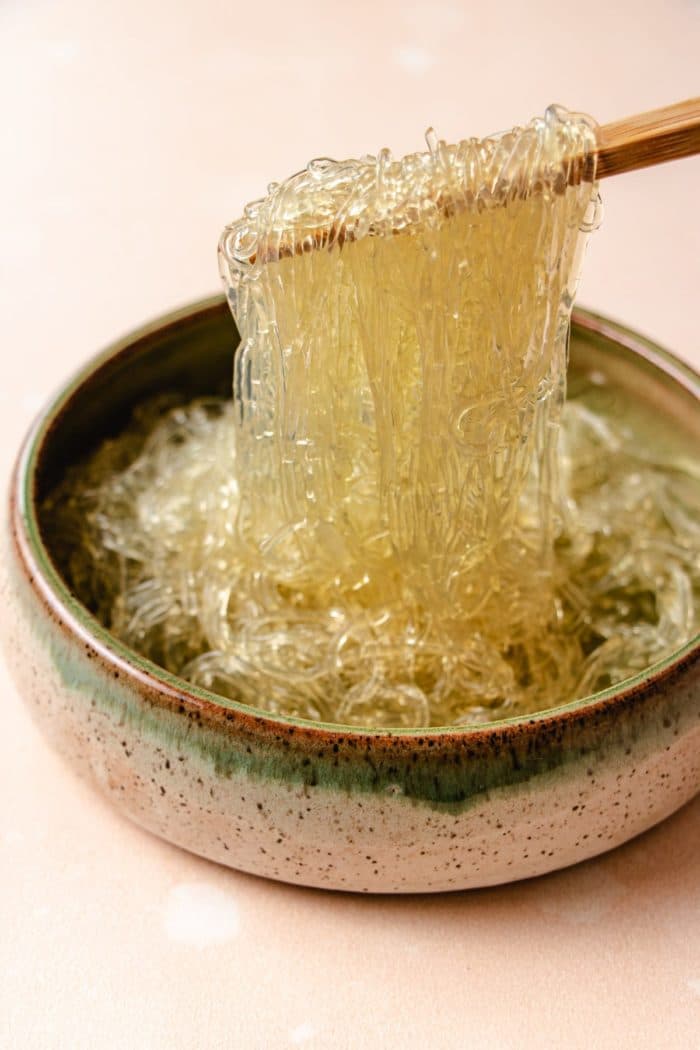
How to make Thai stir fried glass noodles
Like any stir-fry, this bean thread noodles stir fry comes together so fast with minimal prep time.
- Prepare the noodles: Soak in a large bowl with room temperature water for 10 minutes. Drain, cut, and toss the noodles with a small amount of oil to prevent sticking.
- Prepare chicken, vegetables, and sauce: Dry and season the chicken. Dry the shrimp if using. Slice the aromatics and broccoli. Mix the woon sen sauce in a small bowl.
- Cook the proteins: Sear the chicken in a large pan over medium-high heat and set aside. Sear the shrimp, if using, and set aside. Scramble the eggs and set aside.
- Stir-fry the veggies: Saute the garlic, carrots, and onion with a pinch of salt for 10 seconds, stir-often. Turn heat up to medium-high, add broccoli and scallions, saute for 20 seconds.
- Combine and serve: Return the proteins to the pan and add the noodles. Pour in sauce and stir fry glass noodles for 15 seconds. Taste and adjust. Sprinkle it with pepper and serve warm.
How to make pad thai woon sen low-carb
For a low-carb alternative to this cellophane noodles stir fry, use kelp noodles. They are nearly carb-free and flavorless, which allows them to take on the savory flavors of the dish. Once softened with lemon juice and baking soda, their texture closely resembles that of glass noodles.
Adjustments for Using Kelp Noodles:
- Softening the Noodles: Massage the kelp noodles in a mixture of lemon juice and baking soda for no more than one minute. Oversoaking can make the noodles mushy.
- Thickening the Sauce: Since kelp noodles lack the starch found in traditional noodles, they won’t thicken the sauce on their own. Add a small amount of xanthan gum or a starch alternative to the stir-fry sauce to achieve the desired consistency.
- Cooking Technique: Keep your pan hot and the stir-frying time short. Kelp noodles are more delicate than cellophane noodles and require careful handling to avoid breaking.
For more details: see my posts on What are kelp noodles and How to prepare kelp noodles
Make ahead, store, and reheat
- Make ahead: Since this dish has quite a few components, you can slice the vegetables, mix the sauce, and season the chicken ahead. Store them separately in an airtight container.
- Storage and reheat: Reheat leftover pad woonsen noodles in a microwave on medium for 1 to 1.5 minutes. If the noodles feel dry, add a few drops of water to help moisten them.
What to serve with Pad woonsen
You can enjoy pad thai woon sen as a stand-alone dish or serve it alongside your favorite Thai side dishes for a family-style meal. To make things really authentic, serve with Thai chili sauce on the side!
- With curry: Curry dishes are very traditional in Thailand. Pair with these Chiang Mai noodles or Thai curry meatballs for an authentic meal. Try my plant based curry for vegetarian eaters!
- With veggie salad: This Paleo Thai bok choy salad is as simple as it is delicious! It’s made with a chili lime dressing. Or try my Thai basil eggplant dish!
- With meat salad: For meat eaters, you can’t go wrong with a cold Thai meat salad. Try my Thai pork larb or beef larb for an explosion of flavors and textures!
Helpful tips
- Prep the Glass noodles Properly: Soak glass noodles in room temperature water for just 10 minutes. Oversoaking can make them too soft and mushy when stir-fried.
- Use a Large Wok or Pan: Ensure you have enough room to comfortably toss all the ingredients without overcrowding. A large wok or sauté pan is ideal for stir-frying as it distributes heat more evenly and helps to prevent ingredients from steaming.
- Use the Right Cut: Slice vegetables, especially harder ones like carrots and broccoli stems, on a diagonal for faster cooking and better absorption of flavors.
- Balance the Flavors: Start with the sauce quantities suggested in the recipe but adjust according to taste. It should have a savory base with hints of sweetness and acidity.
- High Heat for Stir Frying: Maintain a high heat to ensure vegetables stay crisp and the proteins cook quickly, which helps to lock in flavors and textures.
- Adjusting for Kelp Noodles: If using kelp noodles (low carb), remember they do not absorb sauce like traditional noodles. Increase the seasoning slightly and consider a thickener for the sauce to replicate the dish’s traditional texture.
FAQs
It can be made gluten-free by using gluten-free soy sauce and gluten-free oyster sauce instead of regular soy sauce, and ensuring all other ingredients are gluten-free certified.
Both are Thai noodle dishes. Pad Thai is typically made with rice noodles and has a tamarind-based sauce, giving it a distinct tangy flavor. Woon Sen Pad Thai uses glass noodles and features a milder, savory sauce.
Glass noodles are valued for their unique, springy texture and ability to absorb flavors well, making them perfect for absorbing the rich, savory sauces in stir-fries, soups, and salads.
More Thai stir-fry recipes you might like
If you enjoy this Thai mung bean noodle recipe, here are some more healthy Thai recipes to try!
- Paleo pad see ew made with low-carb zucchini noodles
- Paleo pad thai made with spaghetti squash noodles
- Thai basil beef with tender beef and crisp peppers in a sweet and savory Thai basil sauce
- Thai basil chicken made with flavorful ground chicken and topped with a crispy Thai-style fried egg
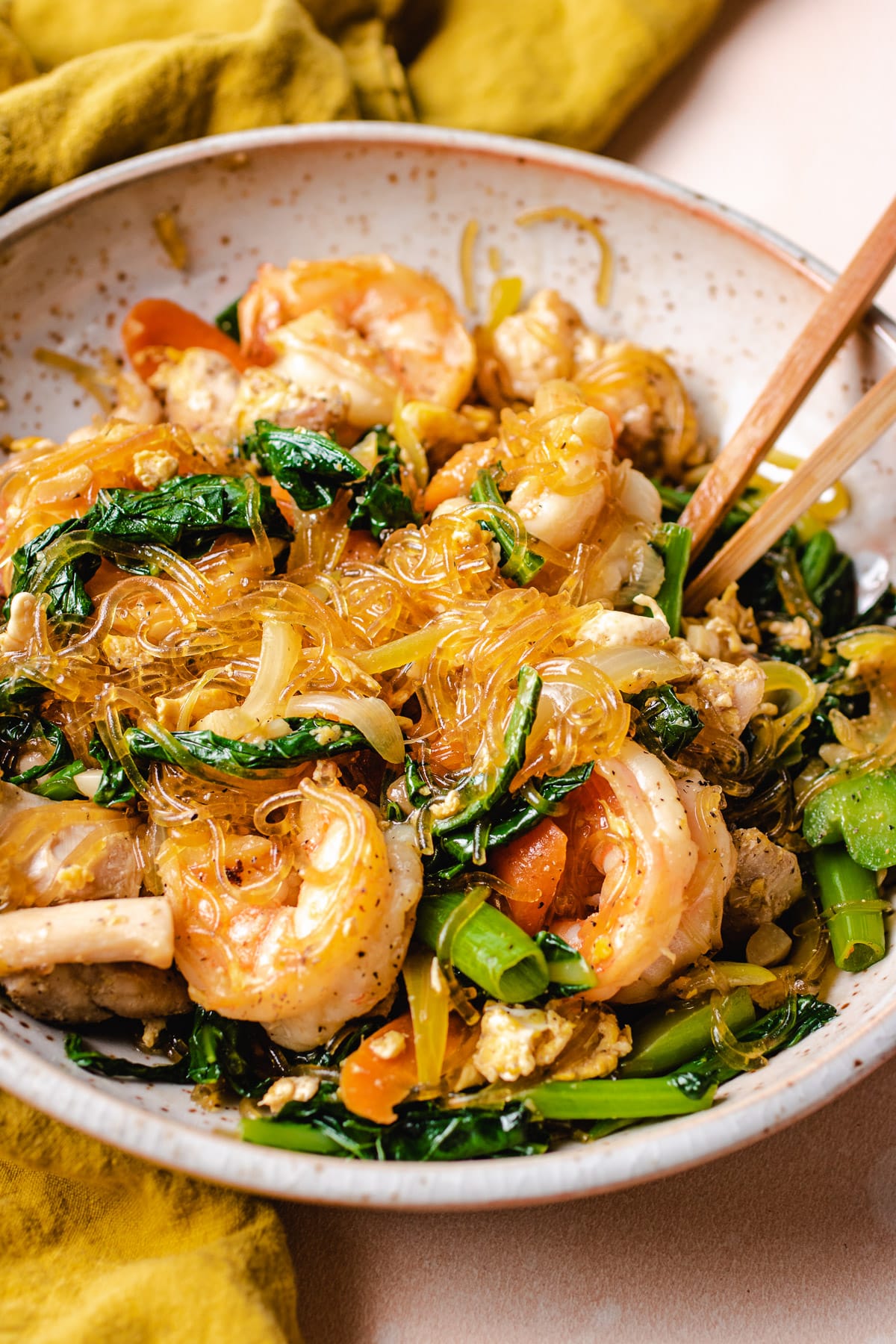
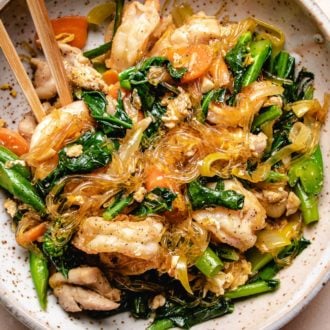
Pad woon sen recipe (Thai stir-fried glass noodles)
Ingredients
- 100 gram glass noodles, also known as bean thread noodles or mung bean noodles
Protein:
- 0.75 lb Chicken thighs, skinless and boneless
- ¼ tsp garlic powder
- ½ tsp coarse sea salt
- ⅛ tsp ground white pepper, or black pepper
- 8 pieces large shrimp, optional
- 2 large eggs
Other:
- 2 oz. yellow onion, sliced, about half of 1 medium
- 0.8 oz. clove garlic, finely minced, about 4 cloves
- 2 oz. carrots, diced on diagonal, about 1 medium
- 2 bulb scallions, , diced to 2-inch sections
- 9 oz. Chinese broccoli, or broccolini
- 3 tbsp avocado oil, divided
- Sprinkle coarse sea salt, coarse sea salt
- Sprinkle ground black pepper
Sauce:
- 1 tbsp soy sauce, or 2 tbsp coconut aminos
- 0.5 tbsp fish sauce, or more if desired
- 1 tbsp oyster sauce
- 1.5 tsp coconut sugar, or keto brown sugar
- 1 tsp ketchup
Instructions
Briefly soak the glass noodles:
- Fill a large bowl with room temperature water, add the bean thread noodles and soak for 10 minutes. Drain then make two cuts with kitchen shears for easy serving and cooking. Toss the noodles with a small amount of oil to prevent them from sticking.
Prepare chicken, vegetables, and sauce:
- Pat dry the chicken and slice to bite sizes. Season with garlic powder, salt, and pepper. If using shrimp, simply pat them dry. Set aside ready to use.
- Prepare the onion, garlic, carrots and scallions. For Chinese broccoli, make a slice to separate the stems from the leaves then slice the stems on diagonal at a 45° degree angle bias cut into thinner slices. Dice the leaves to large sections. Rinse and drain well.
- In a small bowl, mix the woon sen sauce well. Gather the eggs ready to use.
Cook the proteins:
- Preheat a large saute pan, ideally 12-inch wide, over medium heat until the pan is hot. Add 1.5 tbsp oil. Pan sear the chicken over medium-high heat until almost cooked through, about 3 minutes. Transfer out to a plate.
- If adding shrimp, pan sear them over medium heat for about 2 minutes per side. Transfer out to a plate.
- Crack two eggs into the pan. Break the eggs with a spatula as if you are making scramble eggs. Cook for 1 minute. Transfer them out to a plate.
Saute the veggies:
- Using the same pan, preheat it over medium heat for a few seconds. When it’s hot, add the remaining 1.5 tbsp oil, quickly saute the garlic, carrots, and onion with a pinch of salt for 10 seconds, stir-often. Turn heat up to medium-high, add broccoli and scallions, saute for 20 seconds.
Noodles, sauce, and combine:
- Return the chicken, eggs, and shrimp, if using, to the pan. Add the Thai glass noodles and pour-in the sauce. Toss for about 10-15 seconds to incorporate the seasoning. Taste and adjust with the seasoning, if needed. The dish should taste savory, a little sweet with a mild acidic flavor.
- Turn off the heat and transfer them to a large serving plate. Sprinkle with a touch of pepper and serve warm.
Notes
- To modify the dish for low carb, use kelp noodles and thicken the sauce with 1/4 tsp xanthan gum, or 1 tsp tapioca starch. See below on how to prepare kelp noodles or read more from our articles on What are kelp noodles and How to cook kelp noodles.
- To soften the kelp noodles: Take 1 packet (12 oz) of kelp noodles out of the packet and discard the water. In a large bowl, mix ¼ cup lemon juice with 2 tsp baking soda with a spoon. You’ll see bubbles immediately. Immediately add the noodles to the bowl, and massage them for about 1 minute. The noodles will soften. Transfer the noodles to a colander rinse under running water for 1 minute. Set aside to drain well. The noodles are ready to use and eat.
- Bias cut is a crosswise cut at a 45° angle; most often used in cutting vegetables with thick and dense stems. By slicing it into flat thinner pieces, the vegetable will cook faster in stir frying and remain tender and crisp.
- Use a Large Wok or Pan: Ensure you have enough room to comfortably toss all the ingredients without overcrowding.


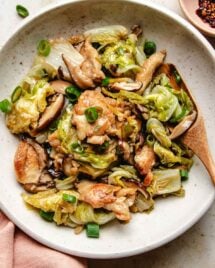
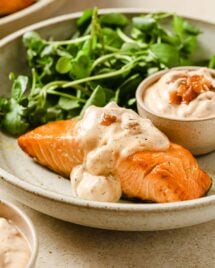
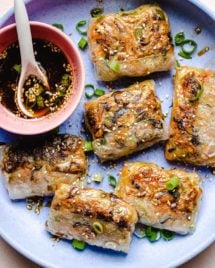
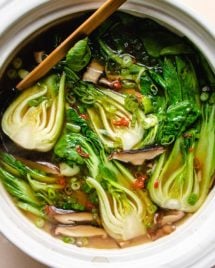
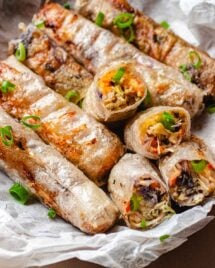
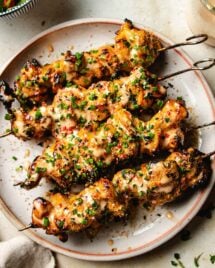
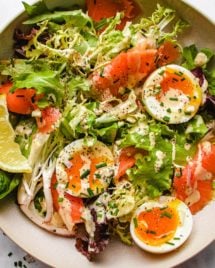
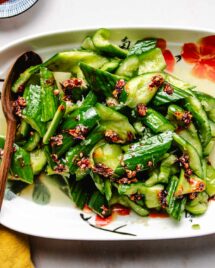
I want to meal prep this and have for lunch a few days in a row. Will the noodles keep ok and reheat in the microwave??
Thanks!!
Hi Erin, yes. You can use kelp noodles (low carb) or regular cellophane noodles or even rice noodles. Divide them to individual serving containers so this way you only need to reheat the quantity you need. I recommend finishing them within 4-5 days. If the noodles get clump up a bit, you can add a few sprinkles of water when you reheat.
The Kelp noodles are SO tasty! And the sauce flavors are wonderful. One direction that confused me: I found 3ish minutes wasn’t enough for the chicken to cook through. I ended up having to keep it in longer after the veggies step. Any tips to avoid that next time? Thank you! Love your recipes.
Thank you. You need to get your pan hot. Use a 12-inch size large skillet for the same recipe quantity of chicken. 🙂
If you want to treat yourself to take our flavors, this is the recipe for you! It is delicious and impossible to tell that it is low carb!!!!!
Thank you, Mariah. So sweet of you!
This is the first I’ve heard of kelp noodles. In my very rural area, it’s not an ingredient I have available locally. Are you familiar with konjak noodles? Would the lemon & baking soda bath have simiyresults in making the konjak noodles softer/less rubbery? Thanks for the inspiration!
I have many konjac noodles (AKA miracle noodles or shirataki noodles) recipes on my site. Please feel free to check them out. Just type “shirataki”. Haven’t tried the lemon bath with them yet. 🙂
So easy and healthy! I was so excited to try these kelp noodles and were amazing. Thank you!
Wow, this dish takes me back to Thai restaurants before my celiac diagnosis. Bowl of delicious comfort! I’ve never had success with kelp noodles, and they had just the right texture this time. Thank you for this awesomeness!
That’s awesome. I’m so happy to hear!
This recipe is FANTASTIC! I did make a few tiny alterations but no issue at all…it was devoured. I am allergic to eggs.so left those out and I ran out of Coconut Aminos so I sub’d Tamari. Lastly, I did add a good amount of crushed red pepper because we are spice addicts.
As always, her recipes are just WONDERFUL in my experience, thank you so much!!!!
These look great! Can you substitute apple cider or rice vinegar for the lemon juice? Thanks1
Yes you can but the noodles might have a slight vinegar flavor.
This dish looks so amazing! I love Thai food and am trying to cut down on carbs – this is perfect!! A delicious and complete meal with so much flavor!
I’ve been wanting to try kelp noodles for so long and this was the perfect excuse! I loved this dish!
Loved this recipe! It was surprisingly filling and came together really quick. I used what I had on hand; I used just shrimp and subbed spinach for broccoli. The sauce really brings the flavor together. Can’t wait to use kelp noodles more!
This looks delicious! Some eaters in my household don’t like seafood. Do you think it would still be okay if I leave out the shrimp?
Yes. Use either chicken OR shrimp. OR a combination.
My first time trying kelp noodles and not only were they delicious but the stir fry was so deliciously flavored!
Thank you for letting us know how to use these kelp noodles. I always thought they are crunchy and didn’t like the texture. But the lemon juice and baking soda seriously made a difference! I sauteed some vegetables with chicken and the noodles, the sauce is amazing – sweet and savory. I’ll be using this low carb noodle more often now. Thanks again!
That’s awesome. I’m so happy to hear!